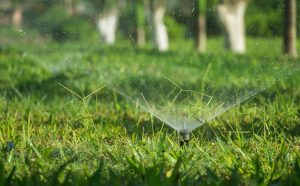Why Mulch Is a Must in Montana Landscaping
Montana’s dramatic weather—cold winters, hot summers, and fluctuating moisture levels—demands thoughtful landscaping strategies. One of the simplest yet most powerful tools for maintaining a healthy, beautiful yard is mulch. At Horizon Landscape & Irrigation, we regularly recommend mulching as a foundational practice for Montana homeowners because it helps conserve water, suppress weeds, and protect plant roots in a climate that can be tough on landscapes.
What Exactly Is Mulch?
Mulch refers to any material applied to the soil surface to protect or improve the area beneath. It can be organic—like bark, wood chips, straw, pine needles, or compost—or inorganic, such as gravel or landscape fabric. Each type has benefits, and the best mulch often depends on the specific application and aesthetic you’re going for.
Mulch in Montana: Why It Matters
Moisture Retention
Montana’s arid summers can dehydrate plants quickly. Mulch helps lock in soil moisture by reducing evaporation, which means less frequent watering and more consistent hydration for your plants—especially valuable during drought conditions or water restrictions.
Weed Suppression
A well-mulched landscape chokes out weeds by blocking sunlight and creating a physical barrier. This reduces the need for chemical herbicides and constant weeding, giving you more time to enjoy your outdoor space.
Temperature Regulation
Mulch acts as an insulator, keeping the soil warmer in winter and cooler in summer. This is crucial for Montana’s native plants and perennials, which can suffer from freeze-thaw cycles or extreme heat stress.
Soil Health and Erosion Control
Organic mulches gradually break down and enrich the soil with nutrients, improving its structure and fertility over time. Additionally, mulch protects against erosion from wind and rain—a major concern in exposed or sloped yards.
Root Protection
Especially important during winter, mulch shields roots from freezing and thawing, which can lead to heaving and plant damage. In spring and summer, it buffers roots from the harsh sun.
Choosing the Right Mulch for Your Yard
Not all mulches are created equal. Here’s a quick breakdown of popular options for Montana landscapes:
Bark and Wood Chips: Great for garden beds and tree rings. Long-lasting and visually appealing.
Compost: Ideal for vegetable gardens and flower beds; enriches the soil as it breaks down.
Gravel or Rock: Works well in xeriscaping and low-maintenance designs. Reflects heat but doesn’t improve soil health.
Straw or Pine Needles: Common in vegetable gardens or rural properties; effective but less tidy.
Our team at Horizon can help you select a mulch type that balances function, longevity, and appearance for your specific landscape.
How Much Mulch Should You Use?
A good rule of thumb is to apply mulch 2–4 inches deep. Too thin, and it won’t offer full benefits; too thick, and it can trap moisture against plant stems or encourage pests. It’s also best to keep mulch a few inches away from the base of plants and tree trunks to prevent rot and disease.
Refresh and Reapply as Needed
Organic mulches break down over time and should be refreshed at least once a year. Spring is the ideal time to check your mulch layer and top it off where necessary. This seasonal update also gives your yard a crisp, clean appearance.
Let’s Mulch Smarter Together
Mulching is more than just a finishing touch—it’s a core part of a resilient, water-wise, and beautiful landscape in Montana. Whether you’re planning a new landscape or want to improve your existing beds, Horizon Landscape & Irrigation can guide you toward the right mulch solution for your yard’s specific needs.
Visit https://horizonlandscapemt.com to schedule a consultation or get a quote on a mulch delivery and installation service. A healthier, more efficient yard is just one layer away.
Read Next: What to Plant—and When—on the Montana Growing Calendar




